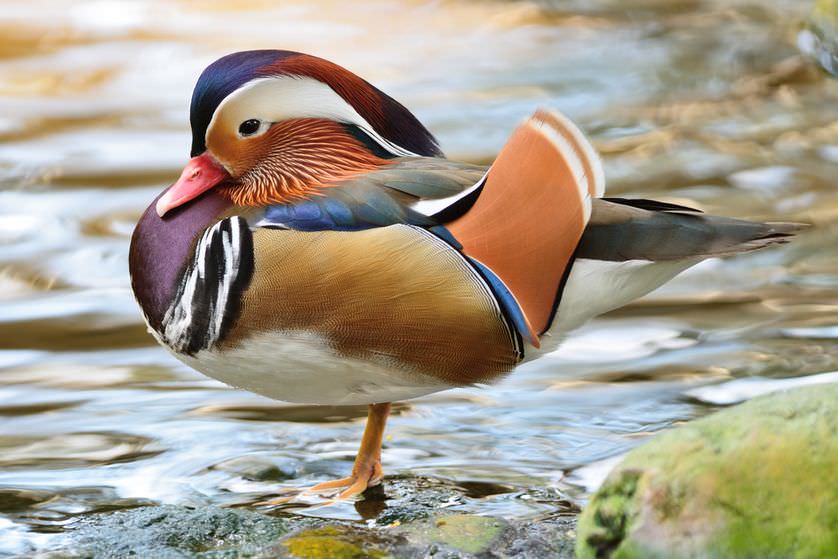Ducks are known to be one of the species that are attractive and irresistible to look at. They are some of the world’s well known and most beloved animals because they make great pets and are highly social animals. There are many species of ducks found around the world that have exotic beauty which are admired by many.
Out of the 120 duck species from all over the world, there are a few on them that are strikingly beautiful as they are rare and outrank the rest. These rare ducks not only come in a variety of shapes and brilliant colors but have mischievous behaviors as well. While most of the species are aquatic birds, some of them prefer fresh water to salt water. Below is the list of some of the most beautiful and unusual ducks from all over the world.
10. White-headed duck

The beautiful white-headed duck is one of the rarest water birds in the world. Both male and female ducks are approximately 45 centimeters long or 19 inches. The males are characterized by their small size, stunning white head, its thick blue bills and stiff tail features. The females have a darker head, grey-brown body and darker brown bill.
The white-headed ducks are usually found on deep wetlands, both in shallow and open water. The species are considered endangered due to the changes of its natural habitat loss, degradation and the threat of hunting which caused a wide range of decline of its population historically.
The ducks are at a very high risk from the brink of extinction. To preserve the population of the White-headed ducks requires an effective conservation of wetlands and control of hunting.
9. Spectacled Eider Duck

The spectacled eider is a beautiful sea duck found in the coasts of Alaska and northeastern Siberia. It is a medium-sized sea duck which is approximately 52.8 centimeters long for males and 49.8 centimeters long for females.
The male spectacled eider is characterized by its white back, yellow-green head, black body with white patches around the eyes while the female spectacled eider is identified by its rich brown color with lighter brown patch of features around its eyes. During the season of late summer and fall, the males are entirely mottled brown.
The diet of this species mostly consists of crustaceans and mollusks in shallow waters and aquatic insects, seeds, berries and grasses from the freshwater. From 1970 to 1993, the breeding population of the species declined by over 96 percent. The cause of the decline was due to climate change and the threat of oil and gas development in the Arctic Ocean.
8. Ruddy Duck

The ruddy duck stands out for its brilliant bright blue bill and is of the stiff-tailed ducks from North America. They are often seen with their stiffed-tailed features that are cocked up in the air. During the winter season, their chestnut bodies as well as their bright blue bill fades to dull gray. In the summer, both male and female ruddy ducks have similar appearance. Their food mainly consists of aquatic crustaceans and plants.
Ruddy ducks breed during the months of spring and summer. During the breeding season, the males perform their courtship by swimming around the female while showing off his bright blue bill and chestnut-colored chest in order to attract any female. When the females are impressed with the court performance, they open their bill while stretching their neck. The breeding areas are on fresh lakes and ponds.
7. Mandarin Duck

The mandarin duck is regarded as one of the most beautiful duck in the world. This duck species is native and was introduced from East Asia.
Today, Mandarin Ducks can be found in several parts of the world including Russia, Korea, England, Ireland and California. The exotic ducks are usually seen on lakes and perch in trees. The male Mandarins have an array of beautiful colors while the female mandarins are dull brown. Both male mandarin duck and female mandarin duck can easily be determined.
In the tradition of Asia, the mandarins are seen as the symbol of love and marriage and pairs of ducks were given to brides during their weddings. It is believed that the Mandarins ducks remain faithful to their mates for life. When one of them dies, the remaining duck will be devasted and have no will to live.
6. Surf Scoter

The surf scoter is an unusual duck that can be found in the coastal waters of the pacific and Atlantic during winter. The sea duck is native in North America. Because of its striking head pattern, the male sea duck is nicknamed “skunk-headed coot.”
The male surf scoters are distinguished by their velvety black plumage, white patches on the forehead and at back of the neck and their colorful bills. The females have lighter black body and white patches on the cheek and their bills are greenish-black.
When feeding, their food source is mostly mollusks. They also dine on crustaceans, aquatic insects, echinoderms, marine worms and small fish. The surf scoter is often seen in harbors, bays and coastal habitats. In the summer, the sea ducks live on small bodies of freshwater in tundra landscapes.
5. Long-tailed Duck

The long-tailed duck is a medium-sized sea duck that possess a small bill and two long and slender tail feathers. The duck was once known as the Oldsquaw in the United States. The plumage of the male duck changes into different color during the seasons of winter and summer. In summer, the white features on the head of the male changes into black. The diving duck prefers to reside in the ocean or on saltwater in winter and artic tundra pools, ponds and streams in summer.
The long-tailed ducks are deep divers that can swim up to 200 feet below the surface of the ocean in order to get food. Of all diving ducks, the long-tailed duck can also remain under water for more than a minute. Their primary source of food is aquatic invertebrates. The ducks also consume crustaceans, small fish, insects, and plants.
4. King Eider

The King Eiders are the largest sea ducks that live in the Northern Hemisphere. The duck gets its name from the distinctive yellow knob on its head, since the knob almost resembles a crown. The duck species resides on the Arctic coast of Alaska, Canada, Greenland, Svalbard and Russia. The male eiders have black body, creamy white chest, bluish grey neck and head, and red bill. The female eiders’ appearances are overall warm brown with black bill.
During the breeding season, the male eiders have much more colorful plumage than the female eiders. In the season of summer, the king eider migrate to Arctic tundra to breed and tend to feed in freshwater lakes and ponds. Their sources of food include fish, squid, mollusks, crustaceans, sea urchins, and star fish. King eider spends most of its time on the ocean when it is not breeding.
3. Hooded Merganser

The hooded merganser is known for its extraordinary black and white crest. They are the second smallest species of merganser and is the only native habitat that can be found in North America. The adult male hooded merganser has yellow eyes, white chest with two black stripes and a white fan-shaped crest on its head. The female hooded merganser has brown eyes, reddish-brown crest and greyish-brown body.
The small diving ducks are usually found around on smalls ponds, rivers and lakes where they dive for food such as fish, crayfish, crustaceans, aquatic insects and other invertebrates. In summer, they reside in creeks, narrow rivers and edges of pond and in winter, they occur on woodland ponds, swamps and small estuaries. The hooded merganser prefers fresh water where it is easily for them to dive down and search for food.
2. Knob-billed Duck

The Knob-billed Duck, also known as Comb Duck, is a unique species because of its large black knob on the bill from the male birds. The species are found in tropical wetlands in Sub-Saharan Africa, Madagascar and south Asia.
They are one of the largest species of waterfowl. The adult ducks have white head freckled with dark flanks. The neck and the underparts are white. The upper parts are glossy blue-black with bluish and greenish iridescence.
The males have a large black knob on the bill whereas the females have a plain bill. The males are larger in size than the females. The unusual ducks can be found inhabiting the freshwater lakes, rivers, swamps, rice fields and marches. They feed on water lilies, seeds, shoots, grasses, small fish, frogs and small invertebrates. During the rainy season, the ducks breed in freshwater swamps and lakes.
1. Smew Duck

The Smew duck is famous for its black and white plumage. The duck is one of the merganser species that can be found in North America, Europe and Asia. They are regarded as one of the most beautiful ducks in the world. The male smew ducks have white body with striking black marking on its head, back and breast.
The wings are dark with large white patches and the eyes are black. The females have a chestnut head, white throat and dark brown eyes. The breast is light grey while the rest of the body is dark grey. Both genders have gray feet.
The smew ducks can be found on fresh water such as lakes and rivers where they dive for fish, which is their main diet. Their foods also include plant material, seeds, snails and crabs.






